The Best?
Which of today’s two featured images do you like best? All are invited to leave a comment and let us know why they made their choice. Be sure to click on each image and view the high-res versions to appreciate the incredible sharpness of a1 images.
What’s Up?
On Wednesday, for the first time in recent memory, I did not get down to the lake at all. I did get lots of work done on my two GNPA Keynote programs.
Today is 25 March 2022. The forecast for the morning is for cloudy early becoming sunny with a gentle NW breeze. I will be headed down to the lake at least to check on the 2-egg crane nest. Wherever you are and whatever you are doing, I hope that you too have a great day. This blog post more than 90 minutes to prepare and makes fifteen days in a row with a new one.
Please remember to use the B&H and Amazon links that are found on most blog pages and to use the BIRDSASART discount code at checkout when purchasing your new gear from Bedfords. Please, also, consider joining a BAA IPT. You will be amazed at how much you will learn …
Great Canon Stuff at Bedfords
Steve Elkins let me know late yesterday that Bedfords has a Canon RF400mm f/2.8 lens in stock along with two EOS R3 bodies in stock. If you bite, please remember to use the BIRDSASART code at checkout to earn 3% back on your credit card and free second-day air Fed-Ex.
And Please Remember
You can find some great photo accessories (and necessities, like surf booties!) on Amazon by clicking on the Stuff tab on the orange/yellow menu bar above. On a related note, it would be extremely helpful if blog-folks who, like me, spend too much money on Amazon, would get in the habit of clicking on the Amazon logo link on the right side of each blog post when they shop online. As you might expect, doing so will not cost you a single penny, but would be appreciated tremendously by yours truly. And doing so works seamlessly with your Amazon Prime account.
Please remember that if an item — a Delkin flash card, or a tripod head — for example, that is available from B&H and/or Bedfords, is also available in the BAA Online Store, it would be great, and greatly appreciated, if you would opt to purchase from us. We will match any price. Please remember also to use my B&H affiliate links or to earn 3% cash back at Bedfords by using the BIRDSASART discount code at checkout for your major gear purchases. Doing either often earns you free guides and/or discounts. And always earns my great appreciation.
Brand-New and As-Good-As-Ever Bedfords BAA Discount Policy
Folks who have fallen in love with Bedfords can now use the BIRDSASART coupon code at checkout to enjoy a post-purchase, 3% off-statement credit (excluding taxes and shipping charges) on orders paid with a credit card. The 3% credit will be refunded to the card you used for your purchase. Be sure, also, to check the box for free shipping to enjoy free Second Day Air Fed-Ex. This offer does not apply to purchases of Classes, Gift Cards, or to any prior purchases.
Money Saving Reminder
Many have learned that if you need a hot photo item that is out of stock at B&H and would like to enjoy getting 3% back on your credit card along with free 2nd Day Air Fed-Ex Air shipping, your best bet is to click here, place an order with Bedfords, and enter the coupon code BIRDSASART at checkout. If an item is out of stock, contact Steve Elkins via e-mail or on his cell phone at (479) 381-2592 (Central time). Be sure to mention the BIRDSASART coupon code and check the box for Free Shipping. That will automatically upgrade to free 2nd Day Air Fed-Ex. Steve has been great at getting folks the hot items that are out of stock at B&H and everywhere else. The waitlists at the big stores can be a year or longer for the hard-to-get items. Steve will surely get you your gear long before that. For the past year, he has been helping BAA Blog folks get their hands on items like the SONY a 1, the SONY 200-600 G OSS lens, the Canon EOS R5, the Canon RF 100-500mm lens, and the Nikon 500mm PF. Steve is personable, helpful, and eager to please.
Important Note
As an Amazon Associate, I earn a small percentage when you purchase from Amazon after using any of the Amazon links on the blog (including the logo-link immediately above). My link works with Amazon Prime and using it will not cost you a single cent. Huge thanks, BTW 🙂
Please Remember Also
Please, if you enjoy and learn from the blog, remember to use one of my two affiliate programs when purchasing new gear. Doing so just might make it possible for me to avoid having to try to get a job as a Walmart greeter and will not cost you a single penny more. And if you use Bedfords and remember to enter the BIRDSASART code at checkout, you will (still!) save 3% on every order and enjoy free second-day air shipping. In these crazy times — I lost about fifty thousand dollars in income due to COVID 19 — remembering to use my B&H link or to shop at Bedfords will help me out a ton and be greatly appreciated. Overseas folks who cannot order from the US because of import fees, duties, and taxes, are invited to help out by clicking here to leave a blog thank you gift if they see fit.


Gear Questions and Advice
Too many folks attending BAA IPTs and dozens of photographers whom I see in the field and on BPN, are–out of ignorance–using the wrong gear, especially when it comes to tripods and more especially, tripod heads… Please know that I am always glad to answer your gear questions via e-mail. If you are desperate, you can try me on my cell at 863-221-2372. Please leave a message and shoot me a text if I do not pick up.
|
|
|
This image was created on 27 May 2021 at Fort DeSoto Park, St. Petersburg, FL. While seated on damp sand, I used the hand held Sony FE 600mm f/4 GM OSS lens and The One, the Sony Alpha 1 Mirrorless Digital Camera. IS 800. The exposure was determined via Zebras with ISO on the rear wheel: 1/4000 sec. at f/4 (wide open) in Manual mode. AWB at 7:27:30am on a hazy, sunny morning. Tracking: Zone with Bird/Face-Eye Detection performed perfectly. Be sure to click on the image to enjoy a higher-res version. Image #1: Tricolored Heron hunting |
Photoshop Crop Tool Basics
Folks often ask if I am wedded to the 3X2 proportions of our images as they come out of Sony, Canon, and Nikon camera bodies. I am not sure why I love the 3X2 proportions (and 2X3 for verticals), but I do. That said, there are times when I prefer crops to other proportions. Those include square crops, boxy crops, and pano crops. In the dropdown Crop menu in Photoshop, there are presets for 1:1 (Square), 4X5 (8X10), 5X7, and others. When you wish to work outside the box as I did with today’s two featured pano crops, or when creating a boxy crop, you need to select the second item in the dropdown menu: W X H X Resolution. Be sure to hit Clear before cropping. Note: you do not have to enter a value in the Resolution box; it will not change if you leave it blank. To set the crop, grab the length and the width love handles (one at a time) and drag them in as needed. You can execute the crop in one of three ways:
- 1- Hit Enter.
- 2- Click on the check mark icon above the image; it is the last one on the right.
- 3- With the cursor anywhere on the image, double-click.
So, What’s a Boxy Crop?
I define a boxy crop as a horizontal image where the proportion is less than 3X2. Both 4X5 and 5X7 are examples of boxy crops, but you do not need to limit yourself to those two. Your images come into Photoshop at 3X2. To create a boxy crop first select the second item in the dropdown menu: W X H X Resolution and then be sure to hit Clear before proceeding. Now grab the love handle on either side of the image and move it in as desired. You can do one or both sides. Now hit Enter. Congrats; you have executed a boxy crop.
|
|
|
This image was created on 12 May 2021 at Fort DeSoto Park, St. Petersburg, FL. While crouching down, I used the hand held Sony FE 600mm f/4 GM OSS lens and The One, the Sony Alpha 1 Mirrorless Digital Camera. IS 400. The exposure was determined via Zebras with ISO on the rear wheel: 1/5000 sec. at f/4 (wide open) in Manual mode. AWB at 8:26:31am on a sunny morning. Tracking: Zone with Bird/Face-Eye Detection performed perfectly. Be sure to click on the image to enjoy a higher-res version. Image #2: Snow Egret hunting |
Wading Birds Fishing: Pano Crops
When actively fishing, wading birds like herons and egrets will often crouch down and lean forward when working the shallows for baitfish. It is natural to work in horizontal format when photographing these fishing birds. And as with today’s two featured images, a pano crop is often the most powerful choice.
Don’t Take This Lightly
Many photo tour leaders are more than glad to get rid of their group at lunch. Each promotion of a BAA IPT includes this:
There will be a Photoshop/image review session after lunch (included) each day.
These sessions are hugely popular. On Day One I will usually pick my keepers from the morning session while explaining the fine differences that make one or two images the best from 5 to 30 frame bursts of the same subject/situation. That is almost always followed by an image optimization or two. Those are recorded and a link to the video is sent to the group.
On the following days, we will look at participants’ images. I will pick a strong one to optimize from the raw conversion to the JPEG creation. And again, the whole process is recorded and a link to the video sent to the group.
These sessions are amazingly valuable, not only for the group but for me as well. Why the latter? Many of my best Photoshop tricks and techniques are a result of someone saying, “Why are you doing it that way? There is a much easier way to do it.”
|
|
|
Fort DeSoto in spring is rife with tame birds, many in full breeding plumage. Click on the composite to enjoy a larger version. Clockwise from upper left around to center: Laughing Gull landing on head of Brown Pelican, Laughing Gull in flight, Reddish Egret sunrise silhouette, Great Blue Heron with needlefish, Yellow-crowned Night Heron with ghost crab, Roseate Spoonbill, Sanderling in breeding plumage, and white morph Reddish Egret in glorious breeding plumage. |
The 2022 DeSoto Spring IPT/April 26 through the morning session on April 29, 2020. 3 1/2 DAYS: $2099.00. Limit: 6 photographers/Openings 3.
Fort DeSoto, located just south of St. Petersburg, FL, is a mecca for breeding terns and gulls and wading birds in spring. Migrant shorebirds are in abundance, and many are exceedingly tame. We should have great chances on Royal and Sandwich Terns and both white- and dark-morph Reddish Egrets. Great Egret, Snowy Egret, Great Blue Heron, Tricolored Heron, and White Ibis are easy as well and we will almost surely come up with a tame Yellow-crowned Night-Heron or two along with some American Oystercatchers. We will enjoy lots of great flight photography.
|
|
|
Again, Fort DeSoto in spring is rife with tame birds, most in breeding plumage. Click on the composite to enjoy a larger version. Clockwise from upper left around to center: Laughing Gull in flight, Yellow-crowned Night-Heron, Sandwich Terns copulating, Roseate Spoonbill, Great Egret with reflection, breeding plumage Short-billed Dowitcher, American Oystercatcher, Royal Tern, white morph Reddish Egret, and Snowy Egret in marsh. |
We will also get to photograph a variety of other shorebirds including Black-bellied, Semipalmated, Wilson’s, and Piping Plovers, Willet, Dunlin, Short-billed Dowitcher, most especially, Red Knot with many individuals in their handsome breeding plumages. In spring the T-shaped peninsula and the newly formed sandbar, Outback Key, are literally packed with avian treasures. With any luck, we might get to photograph one of Florida’s most desirable species: Roseate Spoonbill. And we will almost surely get to do some Brown Pelican flight photography. With luck, they will have Laughing Gulls landing on their heads. And though not guaranteed, Wood Stork might well be expected. And we will be on the lookout for a migrant passerine fallout in the event of a thunderstorm or two.
|
|
|
Yes, Fort DeSoto in spring is rife with tame birds, most in breeding plumage. Click on the composite to enjoy a larger version. Clockwise from upper left around to center: breeding plumage Dunlin, dark morph Reddish Egret displaying, Laughing Gull vertical front-end portrait, Laughing Gull with prey item, landing on head of Brown Pelican, breeding plumage Royal Tern displaying, Royal Terns — pre-copulatory stance, Laughing Gulls copulating, Laughing Gull head portrait, breeding plumage Sandwich Tern with fish, and a rare treat, a breeding plumage White-rumped Sandpiper. |
On the IPT you will learn:
- 1- The basics and fine points of digital exposure; how to get the right exposure every time after making a single test exposure (or before if you are using SONY gear).
- 2- How and why to work in Manual mode (even if you’re scared of it).
- 3- How to approach free and wild birds without disturbing them.
- 4- Lots about bird behavior and how to use that knowledge to help you create better images.
- 5- To age and identify many species of shorebirds including sandpipers, plovers, dowitchers, and possibly yellowlegs.
- 6- To spot good situations and to choose the best perspective.
- 7- To see, evaluate, and understand the light.
- 8- To design pleasing images by mastering your camera’s AF system.
- 9- And perhaps most importantly, to evaluate wind and sky conditions and understand how they affect bird photography.
- 10- How and when to access the magical sandbar safely.
- 11- More than you could ever imagine.
|
|
|
You got it by now! Fort DeSoto in spring is rife with tame birds, most in breeding plumage. Click on the composite to enjoy a larger version. Clockwise from upper left around to center: Roseate Spoonbill, immature Brown Pelican in flight, the heron/egret hybrid, American Oystercatcher feeding, immature Royal Tern on railing, Great Egret morning silhouette, Black Skimmer in surf, and underside head portrait of Great Blue Heron. |
Morning sessions will run at least three hours, afternoon sessions 2 1/2. There is never a set schedule on an IPT — we adapt to the conditions. On cloudy mornings when the photography is excellent, we may opt to extend the morning session and skip the afternoon, especially if the afternoon weather is not looking too good. There will be a Photoshop/image review session after lunch (included) each day. That will be followed by Instructor Nap Time. This IPT will run with only a single registrant (though that is not likely to happen). The best airport is Tampa (TPA). Once you register, you will receive an e-mail with lodging information. Do know that it is always best if IPT folks stay in the same general area — Gulfport in this case, rather than at home or at a friend’s place a good distance away.
Folks attending this IPT will be out in the field early and stay late to take advantage of sunrise and sunset colors; this is pretty much a staple on almost all BIRDS AS ART Instructional Photo-Tours. Doing so will often present unique photographic opportunities, opportunities that will be missed by those who need their beauty rest and those who need to get home for a proper dinner. I really love it when I am leaving the beach at 9:30am on a sunny morning after a great session just as a carful or two of well-rested photographers are arriving … We will be getting wet.
Credit cards are OK for your $500 deposit. You can register by calling Jim or Jennifer during weekday business hours at 863-692-0906 with a credit card in hand. After you leave the deposit, you will receive an e-mail with your balance statement and instructions for sending your balance check. If you wish to pay in full right off the bat, you can make your check out to BIRDS AS ART and send it via US mail here: BIRDS AS ART, PO BOX 7245, Indian Lake Estates, FL 33855. You will receive a confirmation e-mail with detailed instructions, and clothing and gear advice a month before the trip. Please shoot me an e-mail if you plan to register or if you have any questions.
Typos
With all blog posts, feel free to e-mail or to leave a comment regarding any typos or errors.


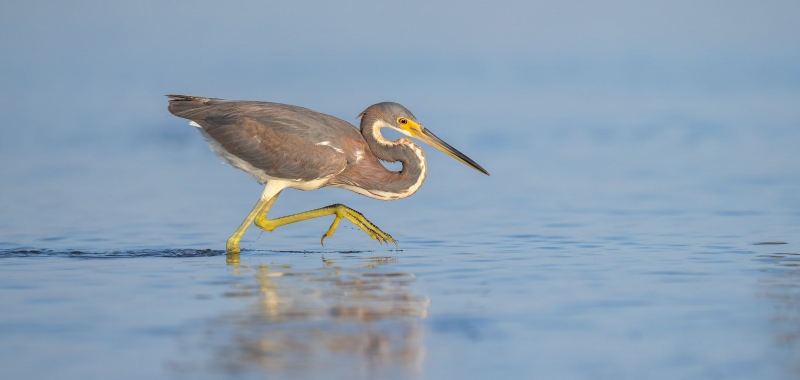
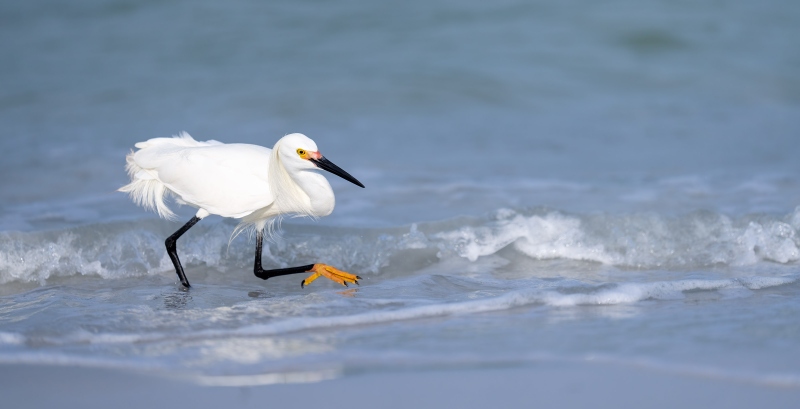
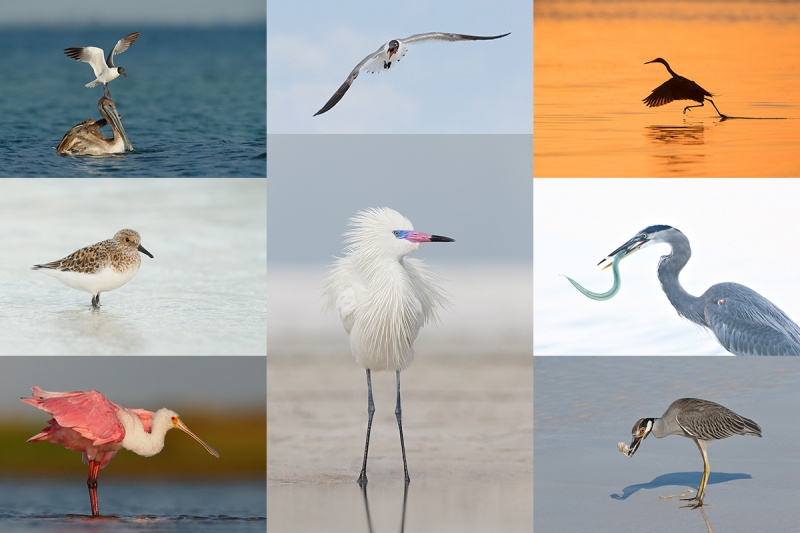
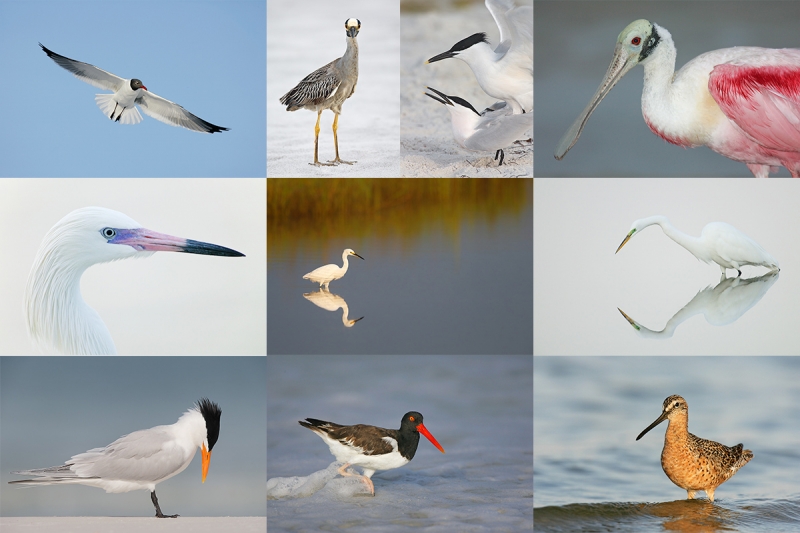
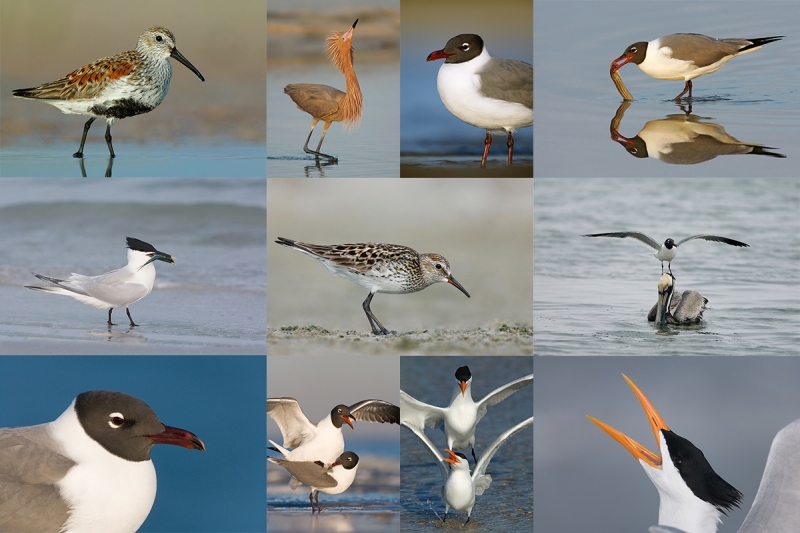
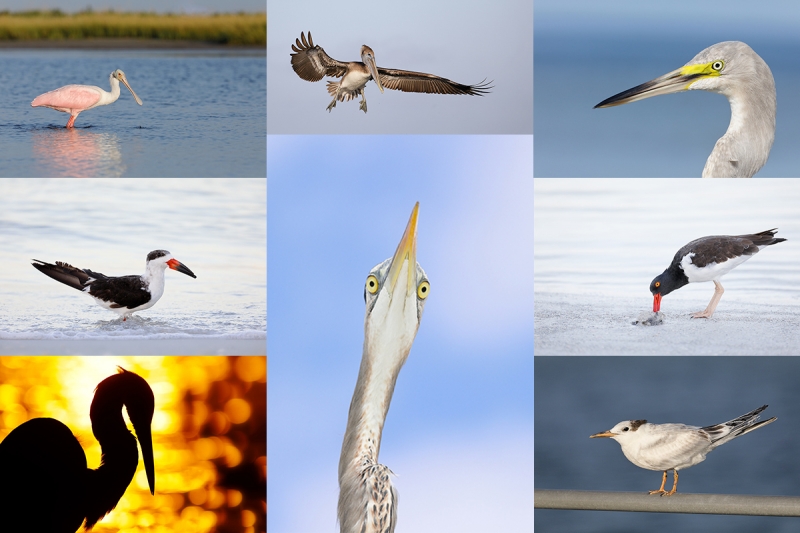













Love the B&W contrast of the Snowy Egret. I think if you were seated for this one, the next breaking wave would ruin the clean background.
Good try but no …
with love, artie
Are the black legs and bill of the Snowy natural because they are wet or……deepened thru software?
I like ’em both. Snowy one of my favorite birds & Tri-Color not found to my knowledge around my neck of the woods so I’ve always enjoyed seeing them in your books and blog.
Thanks for sharing. Glad you recovered all those images from your old laptop & harddrive.
Just wet and me too!
with love, artie
While I like both images, to my eye the image of the Snowy Egret is the stronger of the two. The placement in the frame, body position, the raised foot, and the line of waves just behind the Snowy, leading your eye in and out of the image, all combine for a shot I think most would be happy with. All the best.
Love the raised foot in both images, but the crisp black, white and yellow of the snowy egret is my favorite.
Tricolor for me. Love the shooting angle, DOF, water droplets, foot position, stunning sharpness. Just wish the neck wasn’t resting on it’s back. You were seated….
You were crouching with the egret. I don’t prefer that angle. That’s what really differentiates it for me.
OK. Here is a high level question for you. Why was I crouching not seated for Image #2?
with love, artie
Reasons maybe for crouching: 1) you could track the bird crouched across the wave longer with a little height, while down lower would be fewer frames captured before the wave crashed 2) Where the water breaks, the beach is higher than the water line itself…can’t get low enough, 3) you didn’t want to get your rear end wet ;), 4) maybe something in the background to avoid, 5) Better focus acquisition from above panning rather than a parallel panning position, 6) Head tilted towards plane of focus may mean OOF body if down low and parallel to body, and 7) lastly but not least was because late in the moring sun angle could have deleterious exposure effects.
Can I get half credit if I’m close?
Hi Anthony,
1/2 credit for #7 that works out to 1/14th of a correct answer.
Will post the full answer soon.
with love, artie
I knew there was a reason you put the time stamps on them. Having fun answering!
I like the egret better. There’s the contrast of the black and white, but the white of the surf echoes the white feathers for a more pleasing composition (for me). Plus you used the 600, tilting the scales toward my buying one. Have a great day, Artie!
While I do like them both, I prefer the snowy egret over the tricolored heron. First, there’s the angle of the heron, giving the bird a little more depth. The tricolored heron looks a little flat. Also, the black of the bill and legs really makes the egret standout.